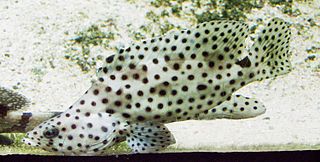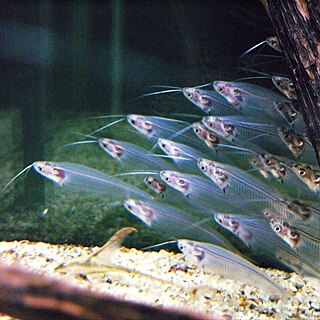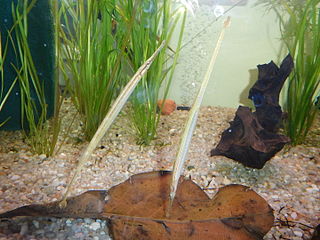
The Serranidae are a large family of fishes belonging to the order Perciformes. The family contains about 450 species in 65 genera, including the sea basses and the groupers. Although many species are small, in some cases less than 10 cm (3.9 in), the giant grouper is one of the largest bony fishes in the world, growing to 2.7 m in length and 400 kg (880 lb) in weight. Representatives of this group live in tropical and subtropical seas worldwide.

The cutlassfishes are about 45 species of predatory fish in the family Trichiuridae found in seas throughout the world. Fish of this family are long, slender, and generally steely blue or silver in colour, giving rise to their name. They have reduced or absent pelvic and caudal fins, giving them an eel-like appearance, and large fang-like teeth.

Ophichthidae is a family of fish in the order Anguilliformes, commonly known as the snake eels. The term "Ophichthidae" comes from Greek ophis ("serpent") and ichthys ("fish"). Snake eels are also burrowing eels, they are named for their physical appearance, they have long, cylindrical snakelike bodies. This family is found worldwide in tropical to warm temperate waters. They inhabit a wide range of habitats, from coastal shallows and even rivers, to depths of above 800 m (2,600 ft). Most species are bottom dwellers, hiding in mud or sand to capture their prey of crustaceans and small fish, but some are pelagic.

Rasbora is a genus of fish in the family Cyprinidae. They are native to freshwater habitats in South and Southeast Asia, as well as southeast China. A single species, R. gerlachi, is only known from an old specimen that reputedly originated from Africa (Cameroon), but this locality is considered doubtful. They are small, up to 17 cm (6.7 in) long, although most species do not surpass 10 cm (4 in) and many have a dark horizontal stripe.

The superorder Elopomorpha contains a variety of types of fishes that range from typical silvery-colored species, such as the tarpons and ladyfishes of the Elopiformes and the bonefishes of the Albuliformes, to the long and slender, smooth-bodied eels of the Anguilliformes. The one characteristic uniting this group of fishes is they all have leptocephalus larvae, which are unique to the Elopomorpha. No other fishes have this type of larvae.

Hirundichthys is a genus of flying fish. They have elongated, moderately thick, ventrally flattened bodies. The pectoral branch of the lateral line is absent. The upper jaw is not protrusible. The dorsal fin has fewer or equal rays than the anal fin; the dorsal fin is low, with the anterior rays the longest, the pectoral fins are strikingly long, reaching to or almost to caudal fin base; pelvic fins are long, reaching beyond the anal fin origin, and their insertion is closer to the anal fin origin than to the pectoral fin insertion.

Cypselurus is a genus of flying fish in the family Exocoetidae.

Cheilopogon is a genus of flyingfishes.

Kryptopterus is a genus of catfishes belonging to the family Siluridae. They are found in freshwater throughout Southeast Asia. The scientific name comes from Ancient Greek kryptós + ptéryx. It refers to the reduced or even entirely absent dorsal fin of these catfishes.

Pangasius is a genus of medium-large to very large shark catfishes native to fresh water in South and Southeast Asia. The term "pangasius" is sometimes used to specifically refer to the commercially important basa fish, P. bocourti.

Microphis is a genus of pipefishes within the family Syngnathidae. Members of this genus are notable among the Syngnathidae for residing in mainly fresh and brackish waters. Adults breed in coastal rivers, streams, or lakes, and fertilized eggs are carried by the male pipefish in a brood pouch extending along his entire ventral surface.

Pseudanthias is a genus of colourful reef fishes of the subfamily Anthiinae, part of the family Serranidae, the groupers and sea basses. They are found in the Indo-Pacific. The species belonging to this genus have a diet consisting of zooplankton, and are haremic. Fishes currently included in this genus were earlier part of the genus Anthias. Pseudanthias is the largest anthiine genus

Lutjanidae, or snappers are a family of perciform fish, mainly marine, but with some members inhabiting estuaries, feeding in fresh water. The family includes about 113 species. Some are important food fish. One of the best known is the red snapper.

Hyporhamphus is a genus of halfbeaks. The species in this genus are distributed throughout the warmer seas of the world, most species being Indo-Pacific and there are some freshwater species.

Osteochilus is a genus of cyprinid fishes mainly found in Southeast Asia with a few extending into adjacent parts of China. Additionally, two species are endemic to the Western Ghats in India.

The scaldfishes comprise a genus, Arnoglossus, of lefteye flounders. They are found in the Pacific, Indian and Atlantic Oceans, including the Mediterranean and Black Sea. They are entirely absent from most of the Americas; the only exceptions are A. coeruleosticta and A. multirastris found off Chile. The genus include both species found in shallow and deeper water. The largest species reaches 28 cm (11 in).

Caristius is a genus of manefishes native to the Atlantic and Pacific Oceans.

Iniistius is a genus of wrasses native to the Indian and Pacific Oceans.
Eupleurogrammus is a genus of cutlassfish from the Indo-Pacific region. They are benthopelagic fishes which occur mainly over the continental shelf where they move upwards in the water column towards the surface at night and feed on small fishes, squid and crustaceans. They have very elongated and highly compressed bodies which tapers towards a posterior point.

Lepturacanthus is a genus of cutlassfish from the Indo-Pacific region. They are benthopelagic species of waters over the continental shelf, it is a predator of a variety of small coastal fishes, squid and crustaceans.



















